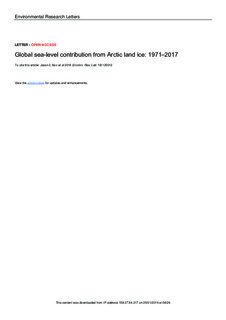| dc.contributor.author | Box, Jason E. | |
| dc.contributor.author | Colgan, William T. | |
| dc.contributor.author | Wouters, Bert | |
| dc.contributor.author | Burgess, David O. | |
| dc.contributor.author | O'Neel, Shad | |
| dc.contributor.author | Thomson, Laura I | |
| dc.contributor.author | Mernild, Jacob Sebastian Haugaard | |
| dc.date.accessioned | 2019-01-31T14:59:05Z | |
| dc.date.available | 2019-01-31T14:59:05Z | |
| dc.date.created | 2019-01-24T11:10:20Z | |
| dc.date.issued | 2018 | |
| dc.identifier.citation | Box, J. E., Colgan, W. T., Wouters, B., Burgess, D. O., O’Neel, S., Thomson, L. I., & Mernild, S. H. (2018). Global sea-level contribution from Arctic land ice: 1971–2017. Environmental Research Letters, 13(12). | nb_NO |
| dc.identifier.issn | 1748-9326 | |
| dc.identifier.uri | http://hdl.handle.net/11250/2583390 | |
| dc.description.abstract | The Arctic Monitoring and Assessment Program (AMAP 2017) report identifies the Arctic as the largest regional source of land ice to global sea-level rise in the 2003–2014 period. Yet, this contextualization ignores the longer perspective from in situ records of glacier mass balance. Here, using 17 (>55 °N latitude) glacier and ice cap mass balance series in the 1971–2017 period, we develop a semi-empirical estimate of annual sea-level contribution from seven Arctic regions by scaling the in situ records to GRACE averages. We contend that our estimate represents the most accurate Arctic land ice mass balance assessment so far available before the 1992 start of satellite altimetry. We estimate the 1971–2017 eustatic sea-level contribution from land ice north of ~55 °N to be 23.0 ± 12.3 mm sea-level equivalent (SLE). In all regions, the cumulative sea-level rise curves exhibit an acceleration, starting especially after 1988. Greenland is the source of 46% of the Arctic sea-level rise contribution (10.6 ± 7.3 mm), followed by Alaska (5.7 ± 2.2 mm), Arctic Canada (3.2 ± 0.7 mm) and the Russian High Arctic (1.5 ± 0.4 mm). Our annual results exhibit co-variability over a 43 year overlap (1971–2013) with the alternative dataset of Marzeion et al (2015 Cryosphere 9 2399–404) (M15). However, we find a 1.36× lower sea-level contribution, in agreement with satellite gravimetry. The IPCC Fifth Assessment report identified constraining the pre-satellite era sea-level budget as a topic of low scientific understanding that we address and specify sea-level contributions coinciding with IPCC Special Report on the Ocean and Cryosphere in a Changing Climate (SROCC) 'present day' (2005–2015) and 'recent past' (1986–2005) reference periods. We assess an Arctic land ice loss of 8.3 mm SLE during the recent past and 12.4 mm SLE during the present day. The seven regional sea-level rise contribution time series of this study are available from AMAP.no. | nb_NO |
| dc.language.iso | eng | nb_NO |
| dc.publisher | IOP Publishing Ltd. | nb_NO |
| dc.rights | Navngivelse 4.0 Internasjonal | * |
| dc.rights.uri | http://creativecommons.org/licenses/by/4.0/deed.no | * |
| dc.title | Global sea-level contribution from Arctic land ice: 1971 to 2017. | nb_NO |
| dc.type | Journal article | nb_NO |
| dc.type | Peer reviewed | nb_NO |
| dc.description.version | publishedVersion | nb_NO |
| dc.rights.holder | © 2018 The Author(s). | nb_NO |
| dc.source.volume | 13 | nb_NO |
| dc.source.journal | Environmental Research Letters | nb_NO |
| dc.source.issue | 12 | nb_NO |
| dc.identifier.doi | 10.1088/1748-9326/aaf2ed | |
| dc.identifier.cristin | 1664275 | |
| cristin.unitcode | 203,12,7,0 | |
| cristin.unitname | Institutt for miljø- og naturvitskap | |
| cristin.ispublished | true | |
| cristin.fulltext | original | |
| cristin.qualitycode | 1 | |

